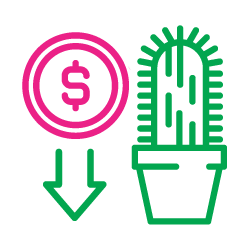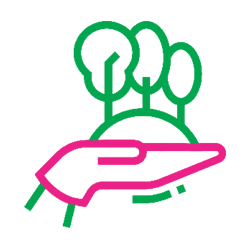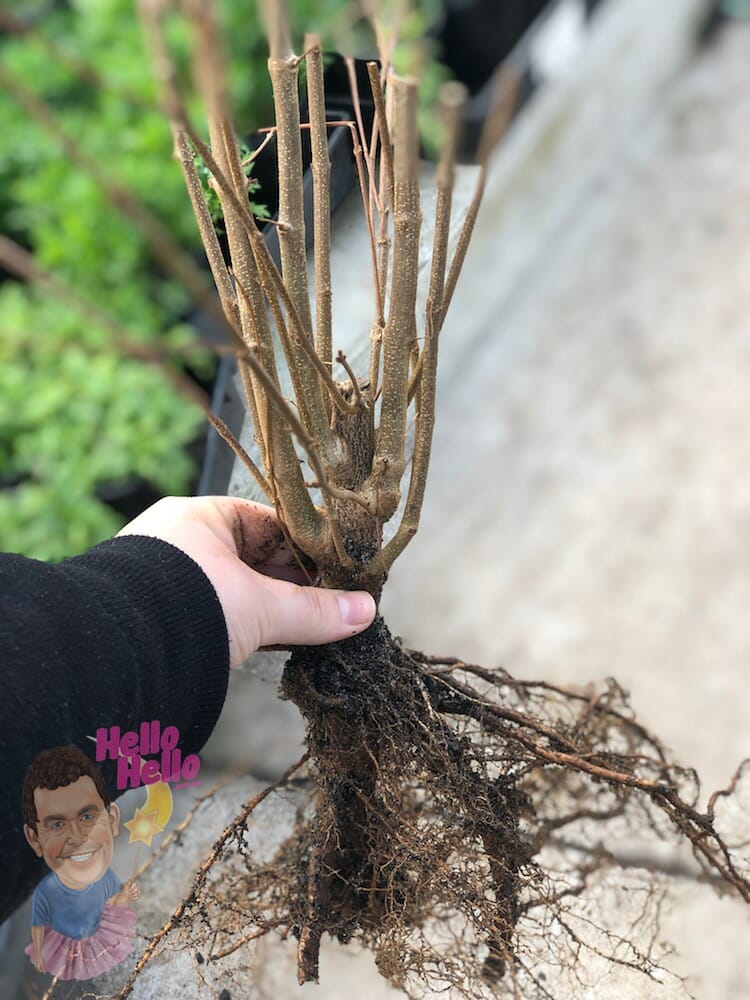
Bare rooted plants are supplied without a pot or soil around the roots. They are mostly deciduous plants that are dormant during the winter time and happily survive this method of storage and transportation. There are also a few evergreen plants, like the very popular Buxus ‘English Box’, which can be bare rooted. Bare rooted plants are also known as field dug.
The benefit of bare rooted plants are: they are cheaper to handle, cheaper to store, cheaper to transport and so we can then sell them cheaper to our customers. Bare root roses, for example, are often half the price of potted roses.
When can you buy bare rooted plants?
Bare root season is only during winter and lasts from approximately May until September in Melbourne and Victoria.
Every year when the cold Autumn rains come to the Dandenongs, growers start digging trees, shrubs, box hedging, roses, berries and fruits trees and vines from the fields. These plants are shaken free of soil, and their roots are kept moist by tucking them into loose moist potting mix or sawdust.
Growers later plant many of them into pots ready for sale in Melbourne nurseries in spring. But some they sell directly to other growers, or to nurseries in this bare rooted form.
The tradition of bare rooting plants
For thousands of years, nurserymen have cultivated shrubs and trees and dug and distributed them as bare-rooted young plants. This was originally because there were no plastic pots or high quality potting mix available in the old days.
In Australia millions of fruit trees, roses and ornamental plants are still grown, dug, and distributed in the bare-rooted form. From a horticultural point of view, this is by far the most economical and best way to produce and distribute plants. It means the buyer gets a bigger, better plant for less, as nurserymen have lower production costs. Plastic pots and their associated costs are not involved.
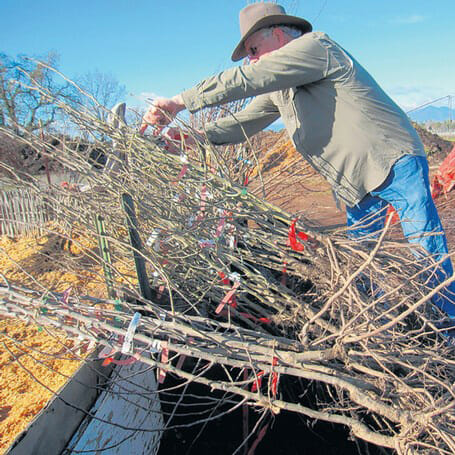
Bare rooted season at Hello Hello Plants
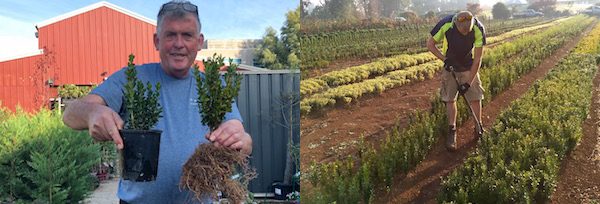
Chris started selling bare rooted plants from his backyard 40 years ago. The art of tucking in and wrapping bare rooted plants properly for sale and transport has been lost in many Melbourne nurseries, and he intends to preserve the bare rooted tradition for many years to come. So come to Hello Hello and get bare rooted!!
Winter is when you’ll find a selection of plant varieties available in the bare-root form, from small to larger sized trees and shrubs including stock that is not available at other times of the year. Bare rooted plants usually appear for sale in Melbourne online and in our Campbellfield nursery after the King’s Birthday long weekend in the second week of June, but the season can start earlier or later based on weather conditions.
When spring comes knocking, plants start budding and warmer weather rolls around, bare rooted plants need to get into the ground quick. This marks the end of the season for selling bare rooted plants.
Bare Rooted Plant Rules
The dormant field digging (bare rooted) season is the time to get planting in the garden, as field dug trees are cheap and easy to transport and plant. As long as you follow these simple rules you can expect your inexpensive bare-rooted trees and shrubs to flourish with little effort.
- Newly planted field dug trees require good drainage. (Check our Wet Feet Kills fact sheet)
- Discard packing material.
- No trimming except for broken roots or branches.
- Plant trees and shrubs to the correct depth in the ground.
- Don’t use fertilizer until the trees are growing (spring).
- Stake appropriately.
- Exercise proper watering, fertilizing, and weed control procedures after planting.
You can learn more about planting bare rooted trees in this fact sheet.
What is the difference between field dug, root ball, and bare root plants and trees?
Field dug trees are trees that have been grown in a cultivated field then once they are dormant (not growing or after leaf drop) they are dug, and either have their roots shaken bare of soil (bare rooted) or their roots kept in a ball of soil and wrapped in hessian to hold the ball together (balled/burlapped).
Root balling is also the preferred method for lifting hardy evergreen trees as it minimizes root disturbance.
Bare rooting is applied to smaller evergreen trees and shrubs such as English Box, Pine, and Spruce, and small to medium-sized deciduous trees and shrubs like Roses, Lilacs, Fruit trees, Birches, Maples, Oaks, etc.
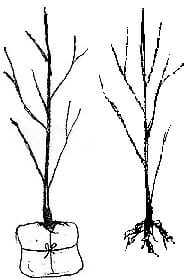
Balled (left) and Bare Rooted (right) trees.
Purchasing bare rooted plants and trees
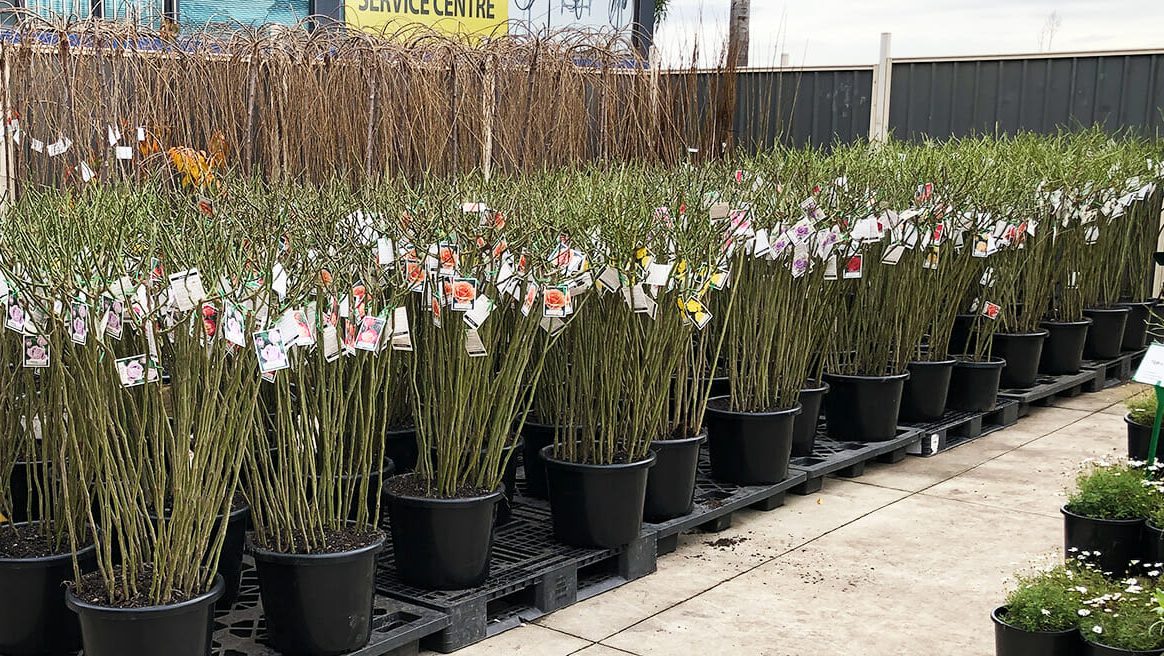
If you’re visiting our Campbellfield nursery, our staff will be happy to help you choose the right trees for your requirements. Once you’ve chosen your trees, pull them out of the soil or sawdust and take them to the dedicated bare root wrapping area in the front shed. We will wrap them in moist sawdust or soil so that they can be transported and stored for a week or two at your home if necessary before they are planted. If you are planning to keep them in a wrapped bundle for a long time, please inform our staff and they will put extra material in your bundle to prevent them from drying out.
Buying bare rooted plants online couldn’t be easier. Wrapping is taken care of before delivery. Please advise our staff in the notes section on the checkout page if you plan to delay planting your plants by more than a week, so they can be wrapped accordingly.
Storing your bare root and field dug trees
If you are not planting your balled or bundled tree for a week or two, place your bundle in a cool moist spot ie. Against a southern wall of the house, under your carport, or under a shady tree. Keep your bare rooted plants out of the sun, and keep their roots cool and moist.
If you would like to store your plants for several weeks or months, you can copy what we do in the nursery and bury their roots with sawdust or soil in a large tub or garden bed. This is called “healing in”, and involves digging a trough in a well-drained garden bed or even a heap of builders’ sand and loosely burying the roots of your bare rooted plants. Unwrap the bare-rooted trees before burying, but keep balled trees wrapped. Keep the area nice and moist, and ensure you remove them from the bed before the 15th of September or they will be growing roots and trying to make it their permanent home!
Most dormant trees and shrubs can be held in a refrigerated cool store between 1-3 degrees for several months if they are packed and stored before the end of August. A lot of professional growers use this method to take advantage of winter bargains and then wait for warmer drier spring planting conditions. If you are planning to cool store your trees, tell our staff as they will need to specially pack your trees.
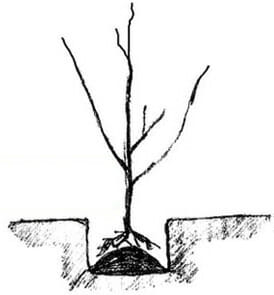
Planting a bare rooted tree
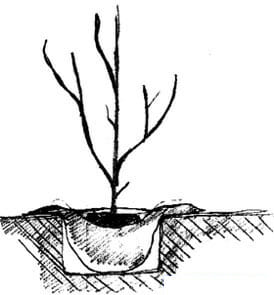
Planting a balled tree.
Planting Instructions
- Remove grass and weeds from the planting area.
- Inspect your soil. The biggest loss of trees in the Melbourne area is due to poor drainage caused by planting into impervious clay and compacted soil. If you are unsure as to how your soil drains, dig a hole and fill it with water from the hose several times. If the water stays in the hole for hours then you have a tree death trap. (Please read our Wet Feet Kills fact sheet)
- When you plant your tree unwrap the plastic wrapping and shake the sawdust free, discard all packing materials.
- Wipe at the base of the tree to see the colour change on the trunk from dark to light. This line just above the roots is the original soil level of the tree. Plant the tree to this depth.
- Spread roots in the hole to break up the soil and spread freely around the roots. If the soil is heavy clay or prone to wet feet, some good quality garden soil or potting mix can be mixed through your original soil. This is also the case if the soil is sandy. Add some good quality potting mix or organic compost to the original soil to help retain moisture.
- Lightly compact the soil with your hands or toes. Water your plants in.
- If planting a balled tree in hessian follow the same procedure but cut the hessian away from the trunk, and lower the ball into the hole using the corners of the open hessian. Leave the hessian around the base of the ball. It will decompose in the hole. Plant the top of the ball level with the soil level.
- Stake appropriately. A small birch seedling or tiny weeping tree may not need a stake. An 8ft Elm or Oak may need two 6ft stakes. A 15ft advanced tree in a windy spot may require 3 star pickets and guy ropes.
- Once established, keep weeds and grass away from the base of the plants. Keep at least a 4ft-circle weed free either by mulching or hoeing up emerging weeds every week or two.
- Occasional deep watering is the best way to water newly established trees, once the ground has started to dry out in mid-spring or early summer.
- Do not use fertilizer when planting bare root trees or balled trees and shrubs in the cold months of winter, as they are dormant and don’t require fertilizer.
- Fertilize in spring with a slow-release fertilizer such as Osmocote. Follow up with several applications throughout the year.
- Between Spring and January, many planted trees and shrubs respond well to the application of foliar feed, which is a type of fertiliser sprayed onto and absorbed by the leaves of a plant. This can be mixed as per instructions. It should be applied with a watering can or spray pack to the foliage & stems, and respray every week or two. This is best done in the cool of the morning or evening when evaporation is low.
Chart: Planting bare rooted roses
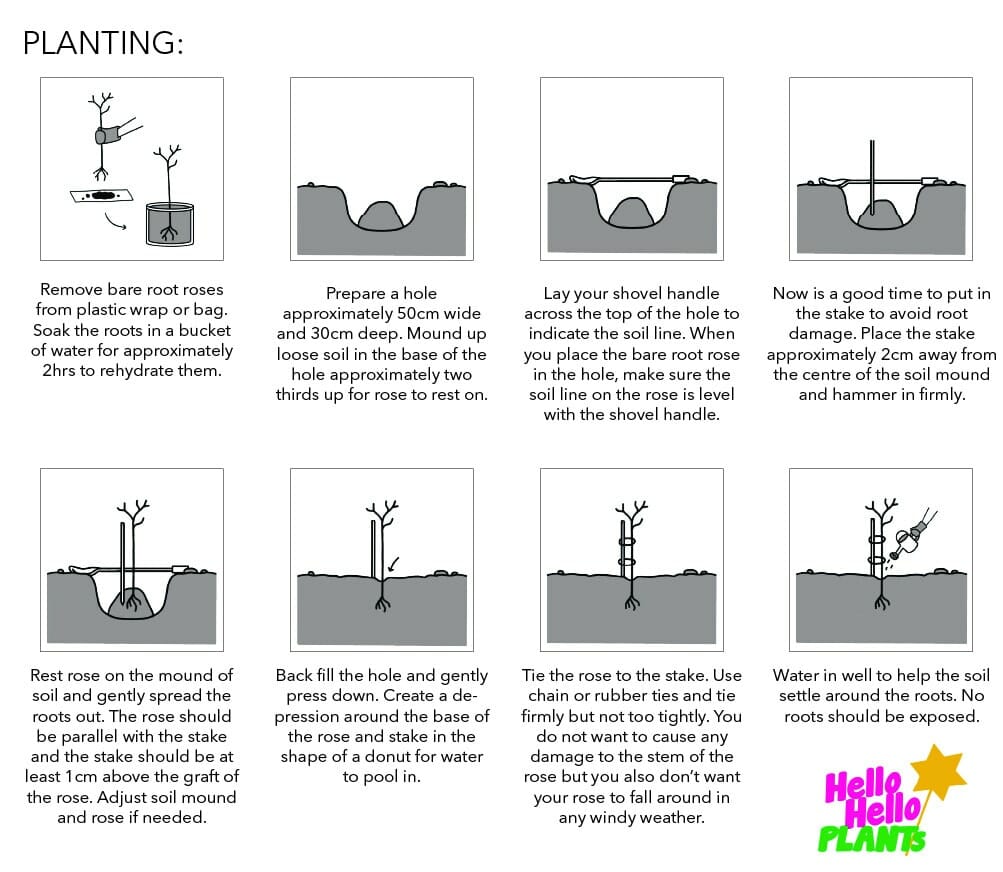
Bare rooted plants for sale this year
- Overview of bare rooted plants for sale
- Bare rooted roses for sale




